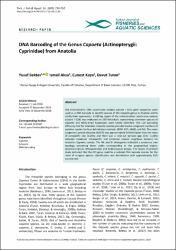DNA barcoding of the genus capoeta (Actinopterygii: Cyprinidae) from Anatolia
Citation
Bektaş, Y., Aksu, İ., Kaya, C. & Turan, D. (2019). DNA Barcoding of the Genus Capoeta (Actinopterygii: Cyprinidae) from Anatolia. Turkish Journal of Fisheries and Aquatic Sciences, 19(9), 739-752. https://doi.org/10.4194/1303-2712-v19_9_03Abstract
The mitochondrial DNA cytochrome oxidase subunit I (COI) gene sequences were used as a DNA barcode to identify species of the Capoeta genus in Anatolia and to clarify their systematics. A 652-bp region of the mitochondrial cytochrome oxidase subunit I (COI) was evaluated on 253 individuals representing seventeen species of Capoeta and thirty-three haplotypes were totally identified. the COI barcoding efficiency test for Anatolian Capoeta species provided twelve congruent numbers of putative species for four delimitation methods (BCM, K2P, ABGD, and NJ). the mean congeneric genetic distance (4.01%) was approximately 14-fold higher than the mean of conspecific one (0.28%) and there was a clear-cut barcode gap (0.92 -1.26%) between maximum intraspecific and minimum nearest neighbour distance for Anatolian Capoeta species. the ML and BI phylogenies indicated a consensus tree topology containing three clades corresponding to the geographical origins: Anatolian-Iranian, Mesopotamian and Aralo-Caspian groups. the results of present study indicated that the COI gene could be a suitable DNA barcode marker for the most of scrapers species identification and delimitation with approximately 81% success rate.


















